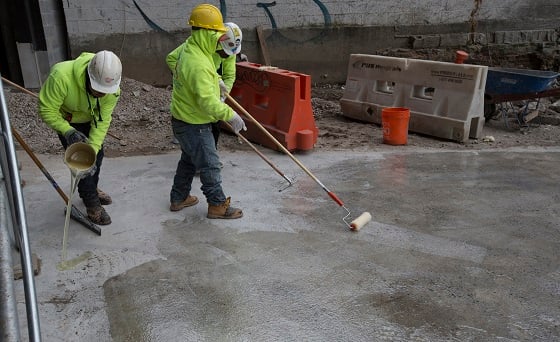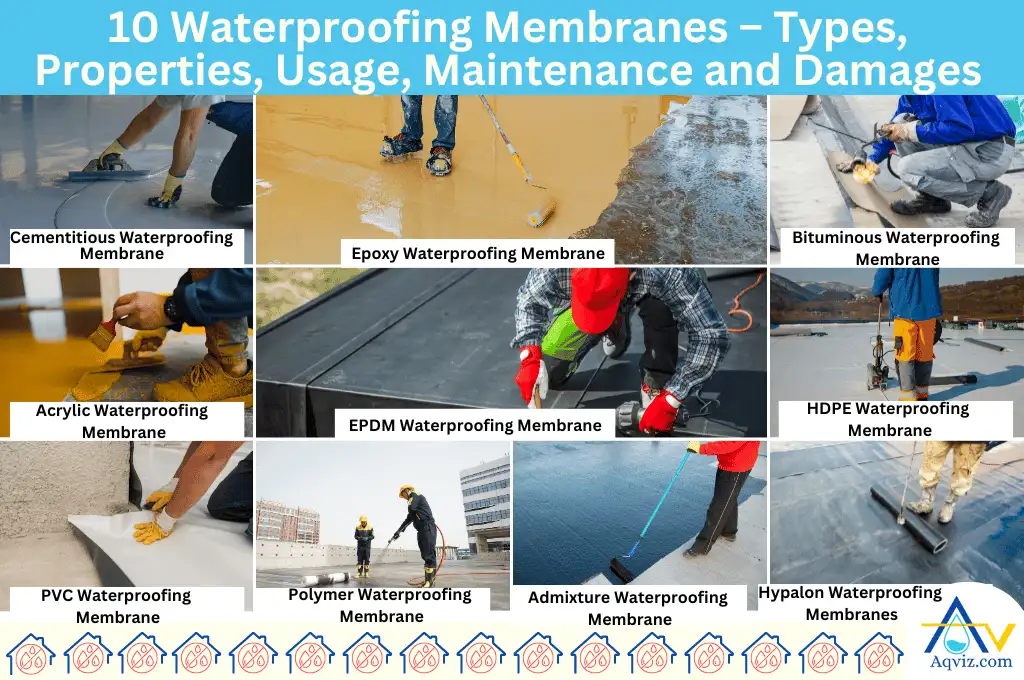
Everything about Waterproofing: Recognizing Its Significance and Benefits for Your Home
Waterproofing is a vital element of home upkeep that many home owners overlook. It offers to safeguard structures from the destructive impacts of water infiltration, which can lead to considerable concerns with time. Understanding the numerous methods and their significance can aid home owners make educated choices. As the discussion unravels, the actual question stays: exactly how can effective waterproofing change a home's resilience against moisture-related risks?
What Is Waterproofing and Exactly How Does It Work?
Waterproofing is a crucial procedure developed to protect structures and structures from water seepage. It entails the application of various products and techniques that produce a barrier, avoiding water from permeating surface areas. Common waterproofing methods consist of using membrane layers, layers, and sealers, which can be put on roof coverings, foundations, and wall surfaces. Each method is chosen based upon the particular requirements and conditions of the structure.The efficiency of waterproofing depends on appropriate setup, ensuring that all locations are effectively covered and secured. Products such as bituminous membrane layers, liquid waterproofing compounds, and cementitious coverings are regularly used, each offering special advantages. Additionally, drain systems may be incorporated to reroute water away from susceptible locations, further improving security. Generally, waterproofing not only safeguards architectural stability yet also boosts longevity, making it a crucial consideration in building and improvement projects.
The Significance of Waterproofing for Property owners
Property owners deal with numerous difficulties in maintaining their properties, and among one of the most considerable concerns is water damage. This concern can develop from numerous resources, consisting of hefty rains, flooding, and plumbing failures. When left unaddressed, water damages can lead to severe architectural issues, mold development, and pricey repairs. Waterproofing stands as a crucial safety net that protects homes from these possible threats.
Usual Waterproofing Methods and Strategies
When taking into consideration waterproofing techniques, house owners can select from a variety of reliable options. Outside waterproofing solutions focus on stopping water from passing through the framework, while indoor waterproofing strategies deal with wetness problems once they have happened. Comprehending these alternatives is crucial for keeping a dry and healthy and balanced home atmosphere.
Outside Waterproofing Solutions
To safeguard a property from water breach, numerous exterior waterproofing solutions can be utilized, each tailored to the certain needs of the framework. One typical method is the application of waterproof membrane layers, which produce a barrier versus dampness. These membrane layers can be either liquid-applied or sheet-based, relying on the installation needs. An additional reliable strategy entails making use of water drainage systems, such as French drains pipes, that redirect water far from the foundation. Furthermore, using exterior sealers can help safeguard surface areas from water penetration and corrosion. Landscaping options, including grading and proper water drainage, can additionally contribute significantly to preventing water accumulation around the structure. Each of these methods plays a vital duty in boosting the longevity and toughness of the residential or commercial property.
Inside Waterproofing Techniques
Inside waterproofing methods are crucial for protecting a home against moisture and water damages. Usual techniques consist of the application of sealers and membranes, which produce an obstacle on walls and floors to avoid water seepage. Inside water drainage systems, such as sump pumps and French drains, effectively redirect water away from susceptible locations. In addition, vapor obstacles can be installed to block wetness from permeating through wall surfaces and floors, specifically in cellars and creep rooms (Landscape drainage Omaha). Regular upkeep and inspection of these systems are essential to guarantee their performance. Furthermore, dealing with any kind of plumbing leakages or condensation concerns without delay can substantially enhance the overall waterproofing approach. With each other, these techniques provide house owners with a detailed method to reducing the risk of water-related troubles

Indicators Your Home Demands Waterproofing
Homeowners must understand vital indicators that their home might require waterproofing. Visible water damage, moldy odors, and constant mold and mildew growth are vital signs that moisture is endangering the stability of the home. Addressing these problems quickly can avoid more damage and guarantee a healthier living environment.
Visible Water Damage
Visible water damages functions as a clear indicator that a home may call for waterproofing procedures. House owners should be cautious for indications such as water spots on walls or ceilings, peeling paint, and deformed floor covering. These visible signs and symptoms usually signify underlying moisture problems that, if left unaddressed, can cause more extensive damage and expensive repairs. Mold and mildew development can also take place, though it will be discussed in the following area. In addition, homeowners should check cellars and creep rooms for wetness or efflorescence on concrete surfaces, which suggests dampness infiltration. Seeing these signs early can aid protect against further damage of the home's architectural honesty. Timely waterproofing actions can protect the financial investment and keep a healthy living environment.
Musty Odors Present
Moldy smells are typically a warning indicator that dampness is remaining in concealed areas of a home, suggesting the requirement for waterproofing solutions. These undesirable scents often arise from moist basements, creep areas, or behind wall surfaces, where water infiltration may not be immediately visible - Landscape drainage Omaha. Home owners ought to pay attention to these smells, as they recommend that excess moisture is trapped, possibly bring about further damage. The presence of musty scents can compromise indoor air high quality, affecting the health and convenience of homeowners. Ignoring this warning indicator can lead to much more severe concerns, making prompt evaluation and activity necessary. By dealing with waterproofing requirements, house owners can eliminate moldy smells and produce a much healthier living atmosphere
Constant Mold Development
Constant mold and mildew development is a clear indicator that a home may be experiencing moisture concerns, demanding waterproofing measures. Mold and mildew prospers in wet atmospheres, making it a considerable problem for property owners. original site Signs of mold and mildew can consist of important site dark places on walls, ceilings, and around windows, in addition to a persistent moldy smell. If mold and mildew appears continuously regardless of cleaning initiatives, it suggests underlying dampness troubles. This can result from leaks, poor drainage, or high humidity degrees. Ignoring these indicators can cause structural damage and wellness risks, specifically for individuals with breathing problems. As a result, resolving waterproofing without delay can help alleviate mold and mildew growth, ensuring a safer and much healthier living environment. Property owners ought to consider expert evaluations to establish the degree of the dampness issue.
The Long-Term Benefits of Purchasing Waterproofing
Purchasing waterproofing offers home owners a profound sense of security and satisfaction, understanding their residential or commercial property is guarded against moisture-related damages. This positive approach significantly decreases the risk of architectural concerns, such as wood rot and structure cracks, which can lead to pricey repair work in time. Additionally, waterproofing helps keep indoor air top quality by minimizing mold and mildew growth, which can have adverse wellness effects for occupants.Furthermore, waterproofing boosts the longevity of a home, eventually maintaining its value. A well-protected property is a lot more appealing to prospective buyers, as they are much less most likely to encounter covert moisture problems. This financial investment additionally adds to energy effectiveness; effectively sealed rooms avoid drafts and lower home heating and air conditioning expenses. On the waterproofing stone walls whole, the long-term advantages of waterproofing not only ensure the structural integrity of a home however likewise cultivate a much healthier living setting and boost the building's bankability.
Selecting the Right Waterproofing Specialist for Your Home
How can a property owner guarantee they select the most qualified waterproofing specialist for their demands? The procedure starts with extensive research and obtaining multiple quotes. Homeowners must seek specialists with a strong track record, verified qualifications, and substantial experience in waterproofing. Inspecting on-line testimonials and asking for recommendations can offer valuable understanding into a specialist's dependability and quality of work.Moreover, it is essential to ask about the details waterproofing approaches each expert employs, in addition to the products used. Homeowners need to validate that the picked specialist is certified and guaranteed, which secures against prospective liabilities. A trustworthy professional will additionally provide a comprehensive contract describing the extent of work, timeline, and service warranty information. By concentrating on these standards, property owners can make enlightened choices, ultimately causing enhanced protection versus water damages and a reliable waterproofing service customized to their home's demands.
Frequently Asked Questions
Can Waterproofing Be Performed In Winter or Cold Climate?
Waterproofing can be challenging throughout winter or cold weather because of reduced temperature levels affecting materials' attachment and curing procedures. Nonetheless, specialized items created for chilly problems can enable successful waterproofing applications even in winter season.
How Usually Should I Waterproof My Home?
The frequency of waterproofing a home commonly relies on various elements, consisting of environment and worldly top quality. Professionals recommend assessing problems yearly and reapplying every five to 10 years, or quicker if significant wear appears.
Does Waterproofing Affect Home Resale Value?
Waterproofing can significantly influence a home's resale value (Landscape drainage Omaha). Prospective purchasers often view waterproofing as a secure versus water damages and mold and mildew, boosting the residential property's appeal and bankability, possibly resulting in greater deals and quicker sales
Is DIY Waterproofing Effective for All Homes?
The performance of do it yourself waterproofing differs by home. Aspects such as building age, ecological conditions, and existing damage influence outcomes. Property owners must assess their details scenarios before attempting do it yourself services to assure long-term defense.

Are There Eco-Friendly Waterproofing Options Available?
Environmentally friendly waterproofing choices do exist, including natural sealers like beeswax and plant-based items. These options decrease ecological influence while successfully shielding structures from water damage, interesting homeowners looking for sustainable choices for their waterproofing requires.